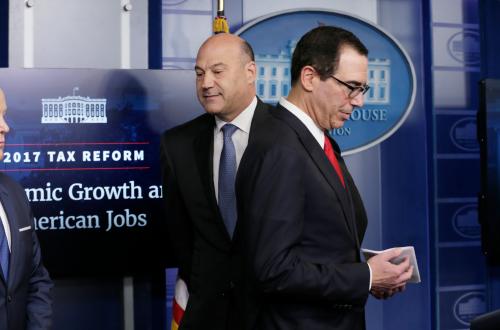This article originally appeared on TaxVox on October 30, 2017.
Congressional Republicans are reportedly planning to propose a major change in the rules for defined contribution retirement plans—401(k)s and similar plans—as part of the tax reform plan to be unveiled on Wednesday. The effort is wrapped in the guise of fiscal responsibility, but it is a gigantic budget gimmick. It’s borrowing in disguise, and on unfavorable terms to the government at that. Worse, it could also undermine workers’ retirement security.
Here’s what’s going on: The Republicans want to cut taxes. TPC estimated that the September Unified Framework would reduce revenues by $2.4 trillion over the next 10 years. But the Congressional budget resolutions set a target of $1.5 trillion in net tax cuts in the coming decade, which means that legislators either will have to find at least $0.9 trillion in new revenues over the next 10 years or trim their tax cuts significantly.
Enter the 401(k) retirement plan, which comes in two forms. In traditional defined contribution plans, participants make tax-deductible (or excludible from tax) contributions during their working life and pay taxes when they withdraw funds in retirement. Those tax deductions reduce revenues a lot in the near term when the contributions are made, but the tax payments on distributions produce more future revenue as workers retire and withdraw from the plans. By contrast, under another type of defined contribution retirement plan, Roth 401(k)s, contributions are not deductible when the contributions are made but qualifying withdrawals are tax-free. Thus, the government loses no revenue up front when the contributions are made but loses a bundle later as retirees take those tax-exempt distributions for life.
To generate much-needed revenue within the 10-year budget window, Republicans may reduce the annual contribution limits on traditional 401(k)s from $18,000 to $2,400 and require people who want to save more to make any additional contributions to Roth 401(k)s. That sound like a technical tweak, but it amounts to a big fiscal sleight of hand.
Forcing people to switch a large portion of retirement saving to Roth-style accounts would not raise overall revenue: It would just shift tax payments from the future to the present. It is like the government saying that it is going to collect some of your 2030 income tax now and credit the future tax liability to this year’s budget.
The amount lost in the future would be at least as big, in present value, as the amount gained now. In its analysis of the Tax Reform Act of 2014, the Joint Committee on Taxation found that cutting the pre-tax contribution limit in half would raise $144 billion over ten years.
The switch could also hurt retirement security. The up-front deduction might be an important incentive for workers to participate in retirement plans. Evidence from behavioral economics suggests that individuals prefer tax breaks up front, which encourages participation and contributions, rather than decades in the future.
Although a recent research paper suggests that contributions might not be that sensitive to the type of account, the shift is risky. We know, for example, that while Roth accounts have been available in most big firms and government agencies for more than a decade, only a fraction of contributions go into such accounts. Most people who have a choice of plans prefer the traditional accounts. Moreover, people with Roth retirement accounts may be more likely to withdraw funds when they change jobs than those with traditional 401(k)s because the penalties are lower. This reduces account balances and, ultimately, retirement security.
We can debate whether a big tax cut bill is appropriate fiscal policy or not. But there is no justification for financing tax cuts with budget gimmicks that would worsen the federal government’s long-term finances. And it’s downright cynical to do so while threatening workers’ retirement security.






Commentary
The budget gimmick that undermines public and private finances
October 31, 2017